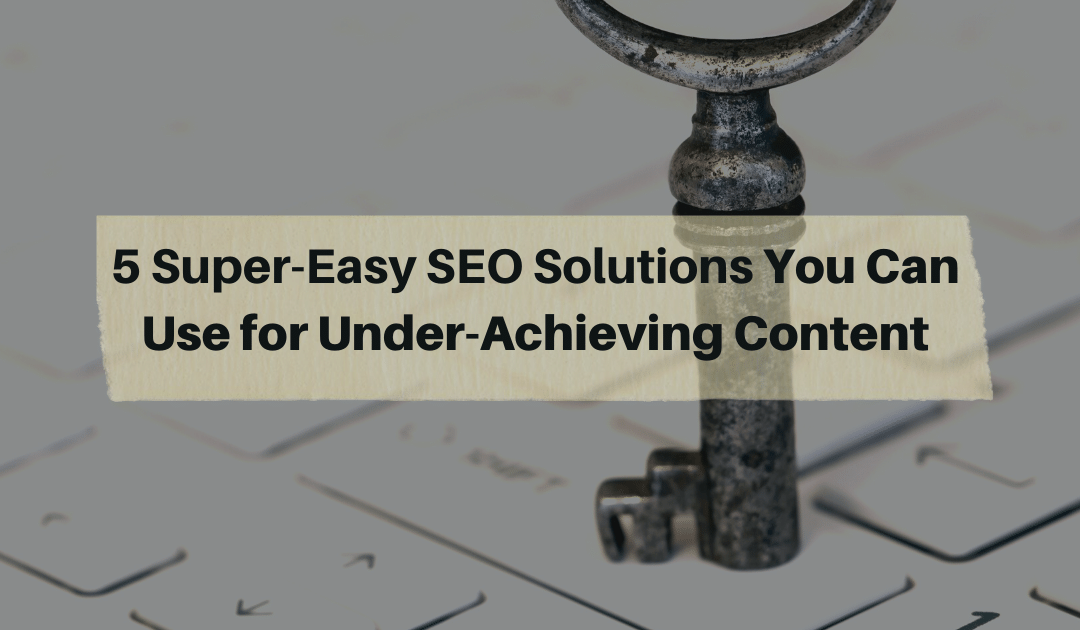The trouble with most SEO solutions to improve your brand’s content marketing efforts is that they seem to take FOREVER to bear fruit. (“Optimize this content for keywords and you should see a boost in rankings…in about 12 years!”)
That said there are some quite easy, quick-hit SEO strategies that can help you derive real benefit. (And you don’t even have to wait a decade!)
So, here are my Top-7 super-easy SEO solutions to get up your search engine game with a minimum of fuss and budget.
SEO Solutions That Won’t Break the Bank (Or Your Patience)
Solution #1: Make Sure Each Piece of Content Passes the “Backspace Question”
Oh, to remember the days when you could just cram your content with meta keywords and meta tags and see the traffic come in. These days Google is more sophisticated, and one of the biggest determiners the “Big G” uses to rank content is “intent.”
Namely, did your piece of content match the intent of the person searching for something?
This may sound a bit abstract — one person’s intent is another person’s 15 minutes of wasted time — but the way Google determined this is did the person hit the “backspace” button after reading your content…and keep looking for the answer to their question.
If they did, you go down in the rankings. If they didn’t, you’re golden.
A couple of questions to ask about your content can help:
- Does this content actually address a single question/concern? (if not — or it addresses too many concerns — might be time to re-think)
- Does it adequately answer the question/concern? (or do we love folks hanging?)
- Is there a way to make the answer super-abundantly obvious? (such as putting a “cheat sheet” or “Summary” at the very top)
Solution #2: Break. Up. Your. Content.
You want people to land on your content. And eventually scroll down so they get to the content below-the-fold.
Unfortunately, most people have the attention span of a gnat…and won’t likely pore through dense text to discover your message.
As an example, which piece of content would you rather read:
Version 1
Which is easier to read? Long blocks of text or short, snappy bursts of text? That is the crucial question plaguing us as content marketers. Here are a couple guidelines: break up your content in short paragraphs (even if not gramatically correct); use bullet points whenever you can; add at least 3-4 subheads to break up the content; use bold, italics and all caps to break up the monotony of your text
Or maybe this:
Version 2
Which is easier to read? Long blocks of text or short, snappy bursts of text?
That is the crucial question plaguing us as content marketers. Here are a couple guidelines:
- Break up your content in short paragraphs (even if not gramatically correct)
- Use bullet points whenever you can
- Add at least 3-4 subheads to break up the content
- Use bold, italics and ALL CAPS to break up the monotony of your text
And here’s the cool part. I haven’t changed a single word of content.
All I’ve done is organize it a little differently — will take you five minutes — and suddenly it becomes much, much easier to scan and eventually read.
Solution #3: Boost Time on Page With Multi-Media
If you go with one of those many affordable SEO services out there — I used to work for one these type firms; I should have put “affordable” in quotes — they will talk endlessly about boosting the “time on site” or “time on page” for your website. They will tell you the Google Gods have spoken from on high and that visitors spending time on your site and not bouncing away is an important part of your site’s ranking.
And they’re absolutely right.
But before you fork over that $2000/month to an SEO firm to help boost your “time on site,” let me give a you a couple super-quick, ultra-cheap ways to boost “time on page” for any piece of content:
- Embed a YouTube video – Real simple. Find a video around the topic of your content and throw it in there. If you’re freaked out about your competition showing up in a YouTube video. Choose a Ted Talk or a Vimeo video. Those aren’t burdened with too many ads. (IF there’s a specific part of the video you reference, be sure to tell folks when it is.)
- Embed an infographic – I know these are branding pieces for other people. That’s okay. Don’t worry about it. They look cool and people will associate yoru stie with the info. (Check out this blog post to find good sources)
- Embed a podcast or audio file – There are podcasts out there about almost everything. Find something interesting and throw it in there.
- Add Estimated Reading Time – You wouldn’t think this would help “time on site.” But it does. By telling people how long the mental commitment is for content, the more people will stick around. (This very site you’re reading has it.) The “Reading Time WP” plugin works great if using WordPress, otherwise you might need some customizing from a developer.
Solution #4: Add a Reputable External Link
Google really likes to see your content link to somewhere other than yourself. I think it establishes “authority,” whatever the hell that means. And with Wikipedia, YouTube, and tons of other resources its easier than ever to throw in a quick link to somewhere off-world.
Don’t worry. If your content is halfway-decent, they’ll come back. Just make sure that you create a link that opens the new page in a new window. You don’t want to give generating leads for somebody else if you don’t have to.
Solution #5: Add an Internal Link to Related Piece of Content (and Vice Versa)
Here’s the rule: every piece of content you have should link to another piece of related content. And then that related content should be link back to the original guy.
And the links should use anchor text, which is just a fancy word for the keyword that destination page is trying to optimize for.
to make this process simpler, I like to create clusters around a single topic.
Using this very column as an example:
- I created a cluster of three articles around the topic SEO (“Seo solutions”; “cheap SEO“; “affordable SEO services”)
- I published the article you’re now reading — the “SEO solutions” one — and linked to the other two articles, using the exact phrase of the destination page as anchor text (Check previous bullet to see what I mean)
- I then went over to those destination pages and linked back to THIS URL using the anchor text “SEO solutions”
So, why is this important? It….
- Makes the navigation of your site much easier (Google wants every piece of content to be reachable within 4 clicks)
- It organizes your content into little clusters of intent (Google loves this)
- It gets secondary and tertiary keywords into your content without sounding like a robot (Google likes this)
- It boosts “time on site” as it gives the visitor some more juicy content to check out
But what do you do if you’ve already written the content? Just go back and add 1-2 related keywords and link out to those other pages.
Try not to think of this internal linking as a limitation. It can actually give you the motivation you need to structure and organize your content. Because when you do that the Google Overlords will reward you with a boost in traffic, making your under-achiever content into an over-achiever rock star.
What’s Your Take on SEO Solutions for Under-Achieving Content?
Got a few SEO solutions for content that just ain’t ranking like it should? Let us know in the comments below.






Facebook Comments